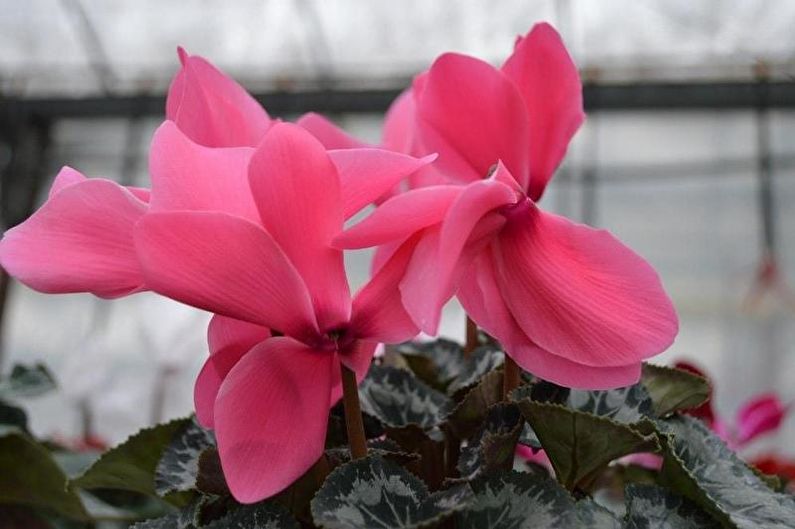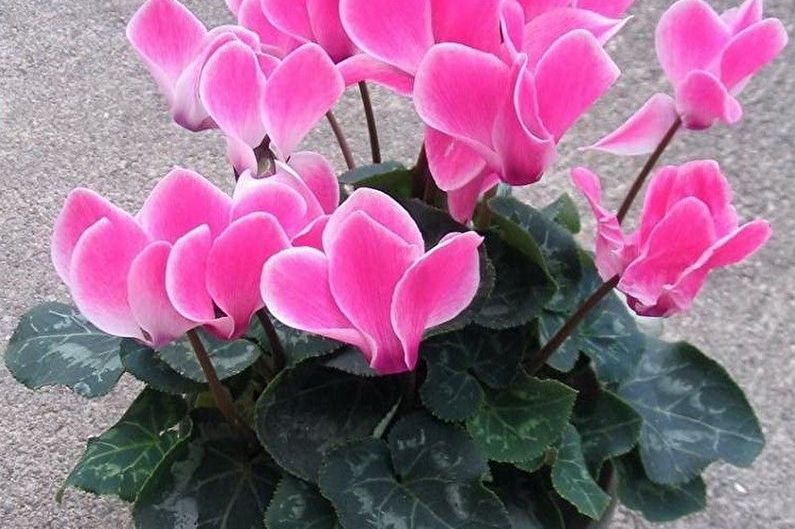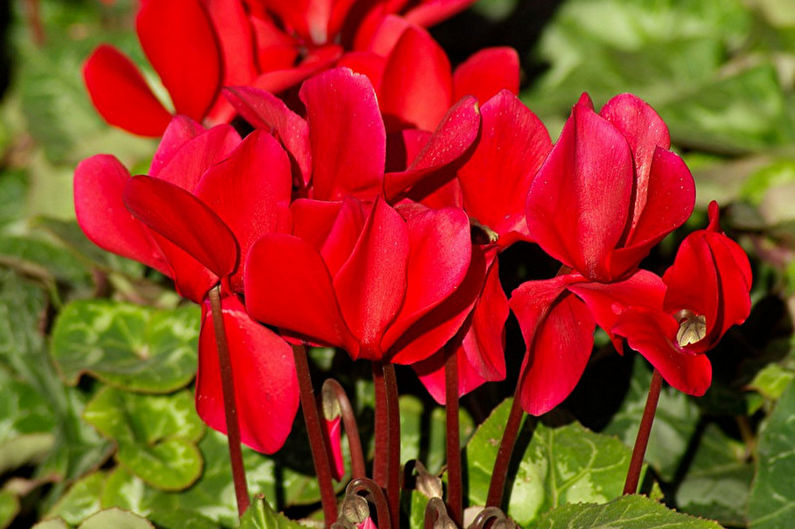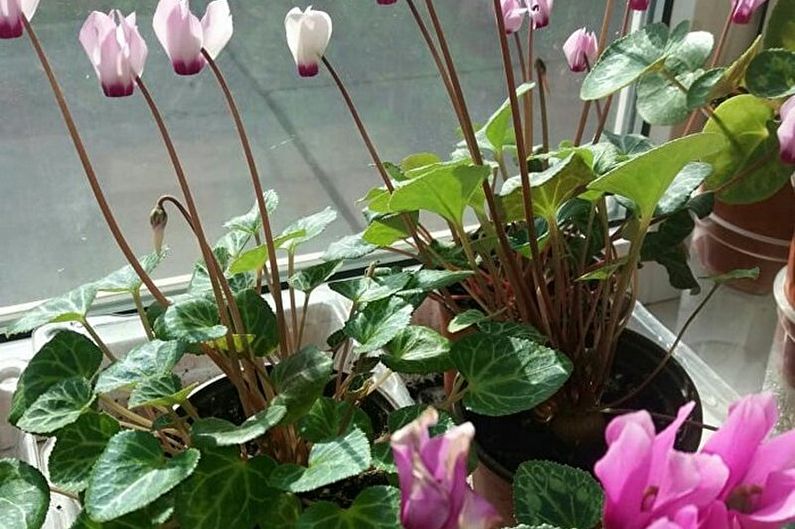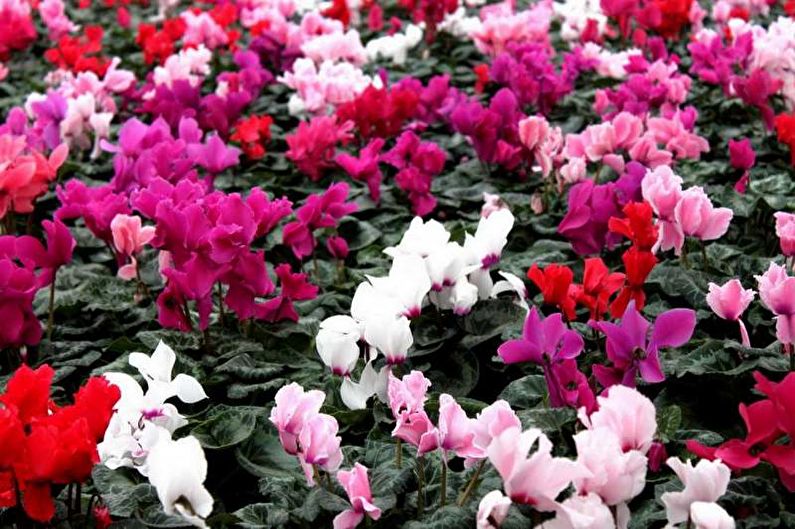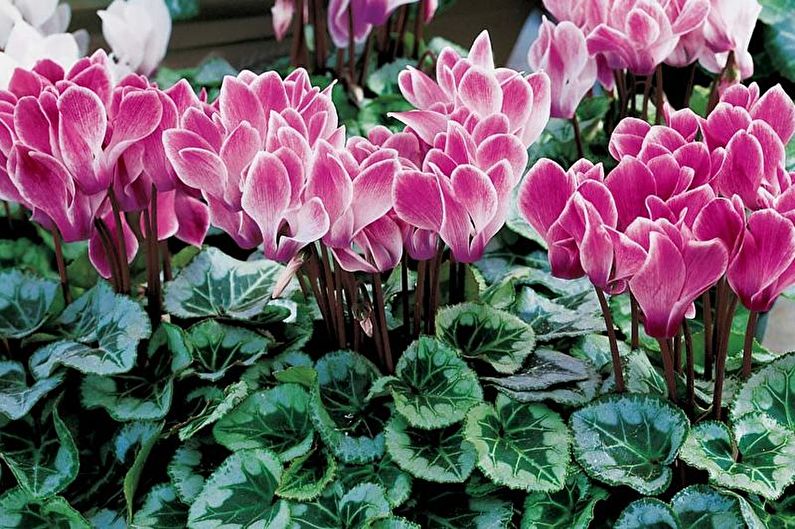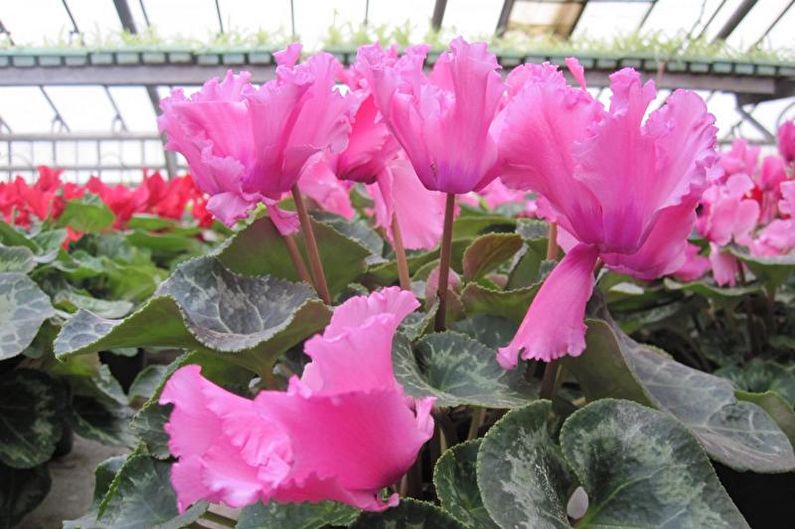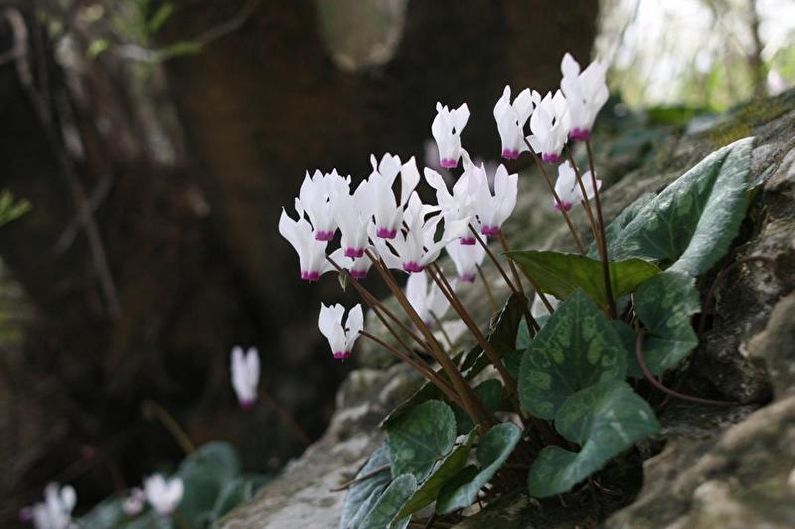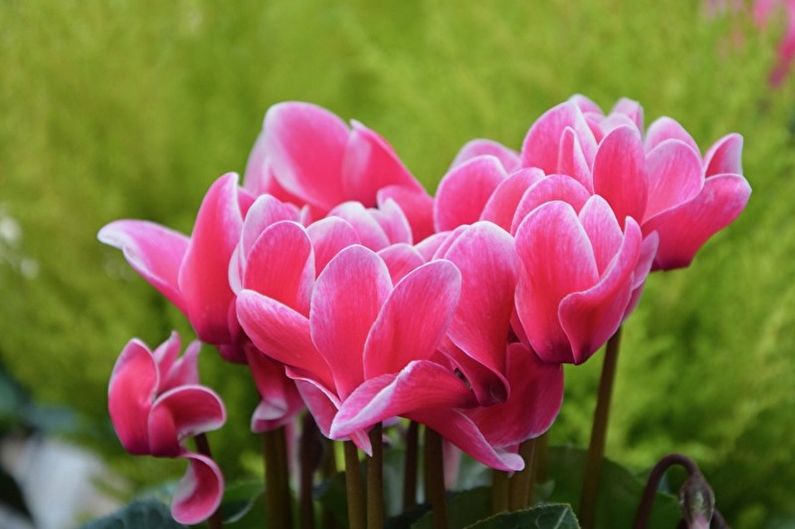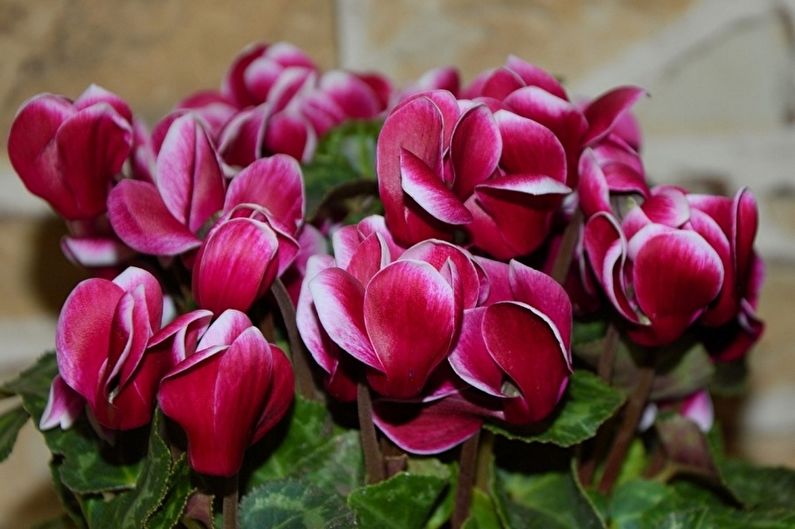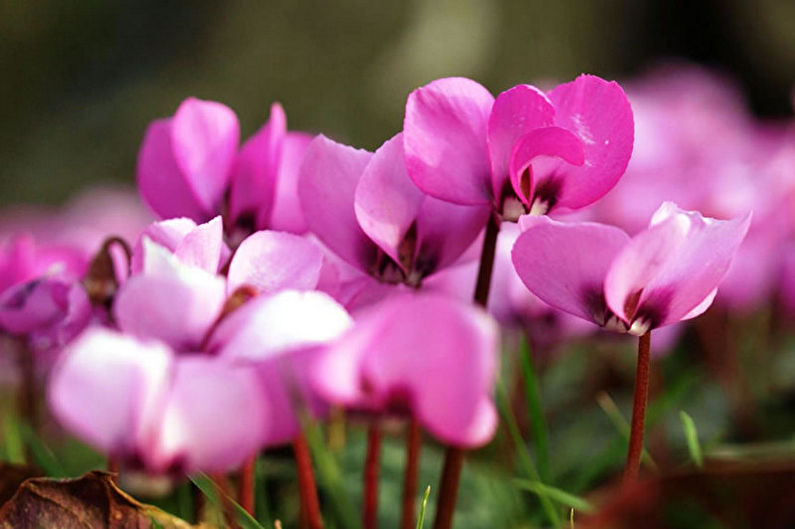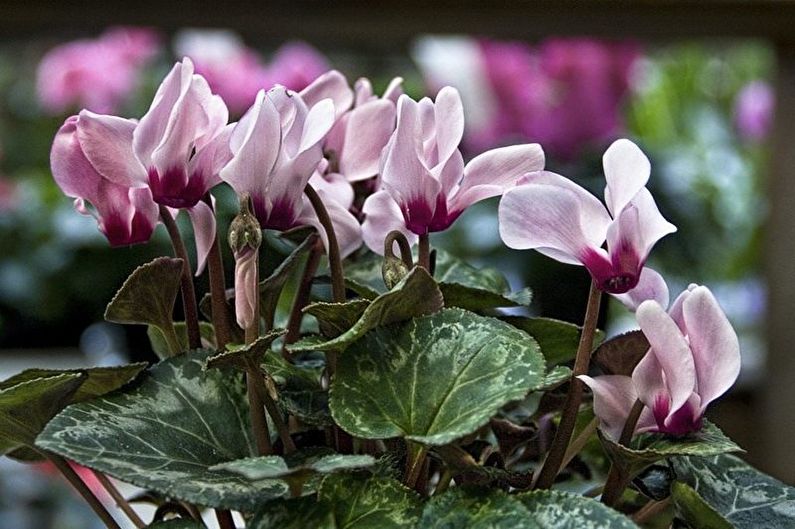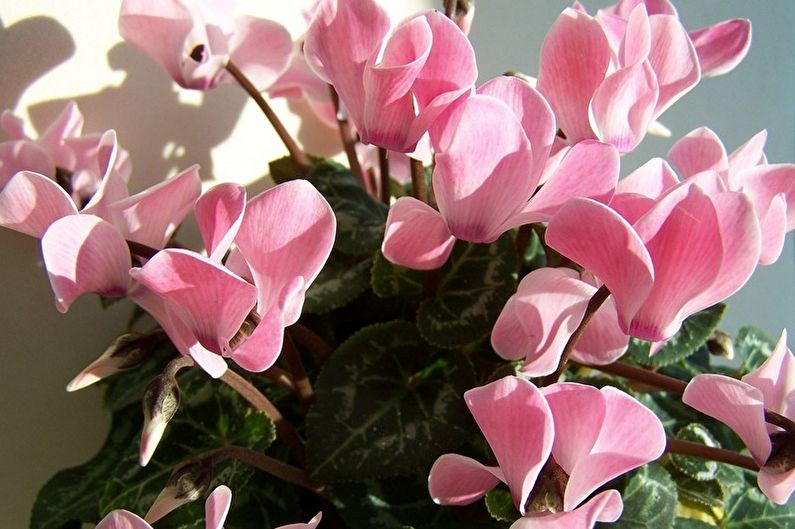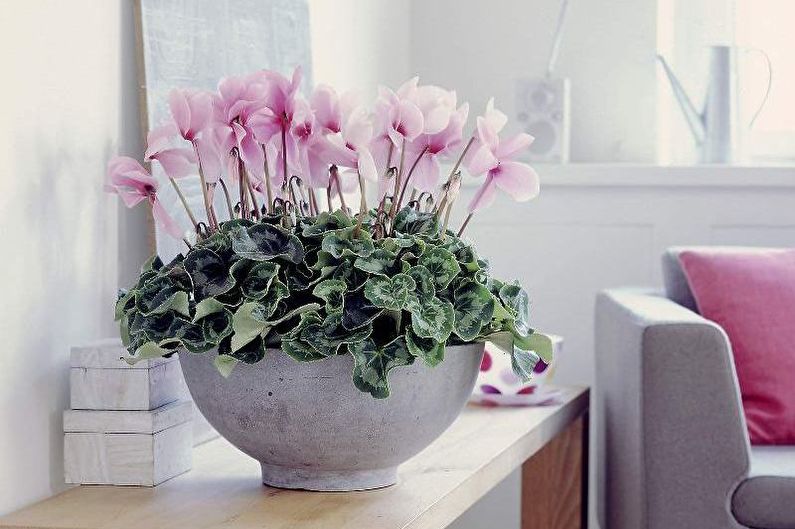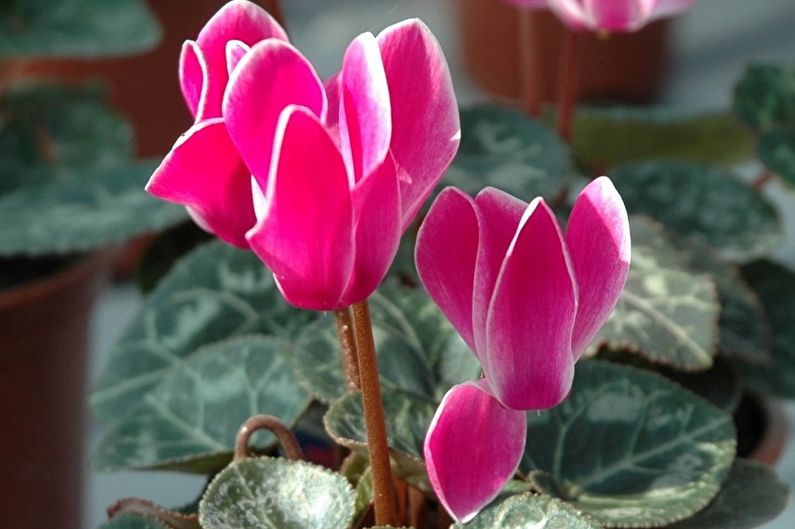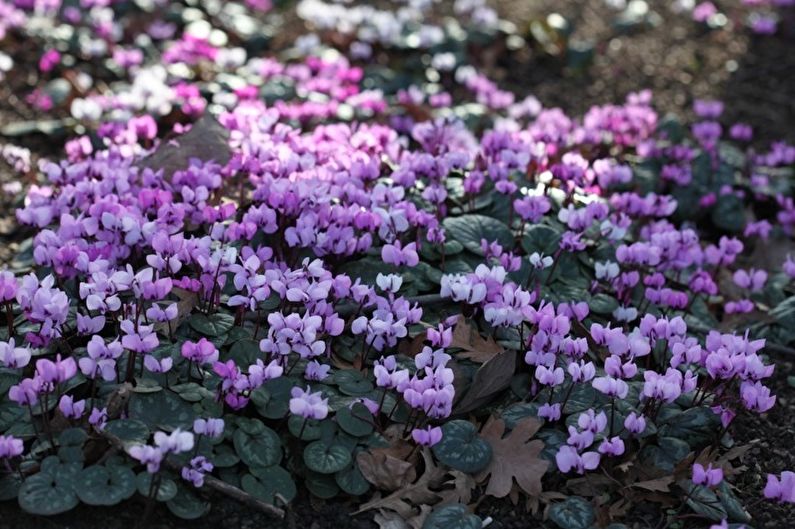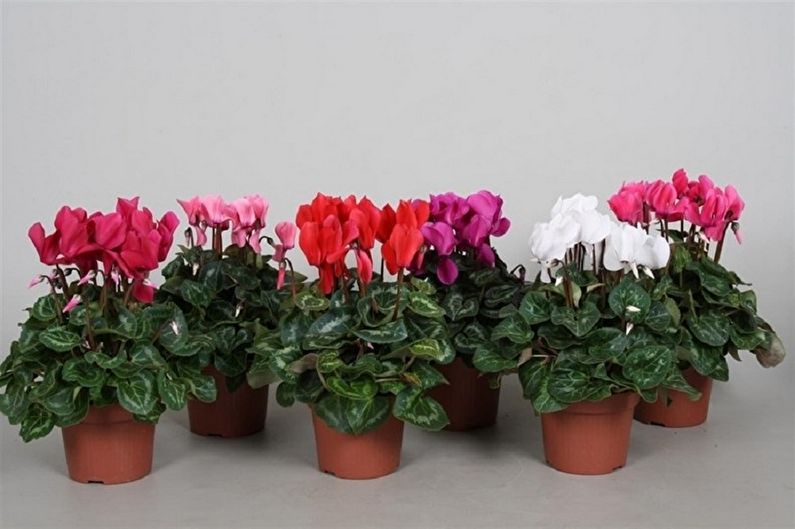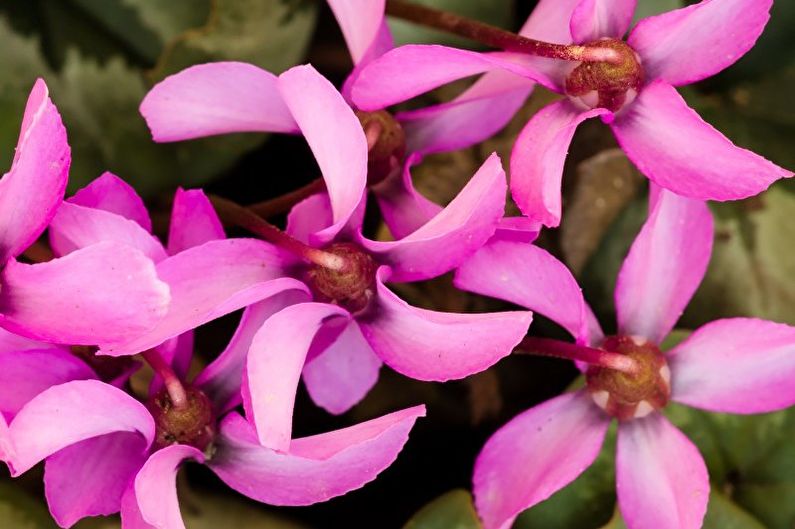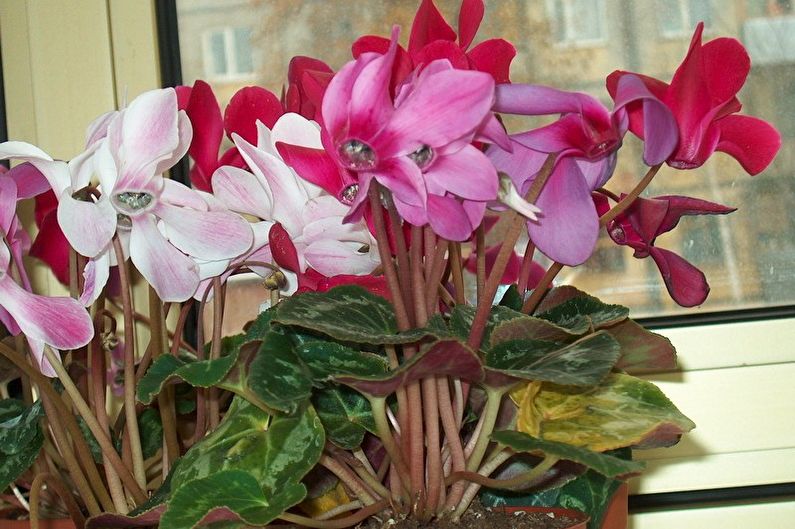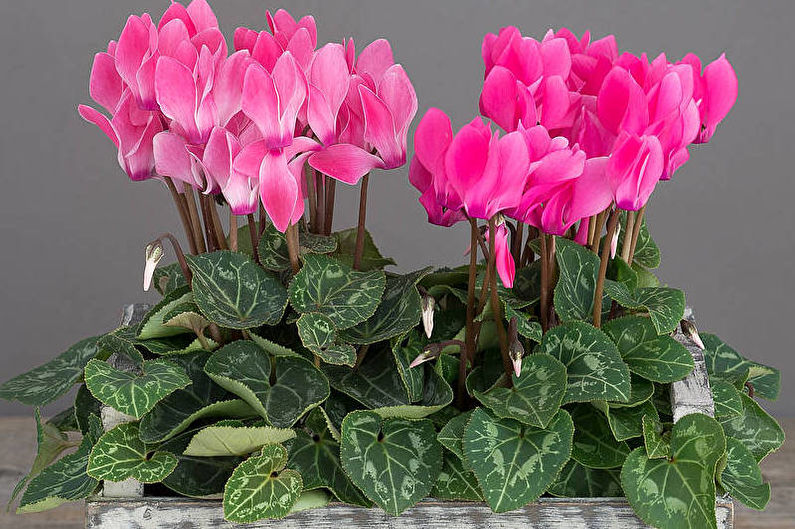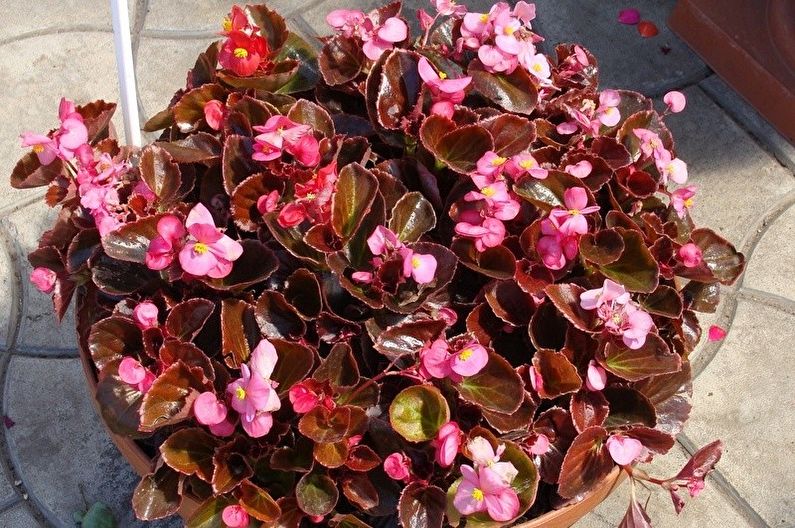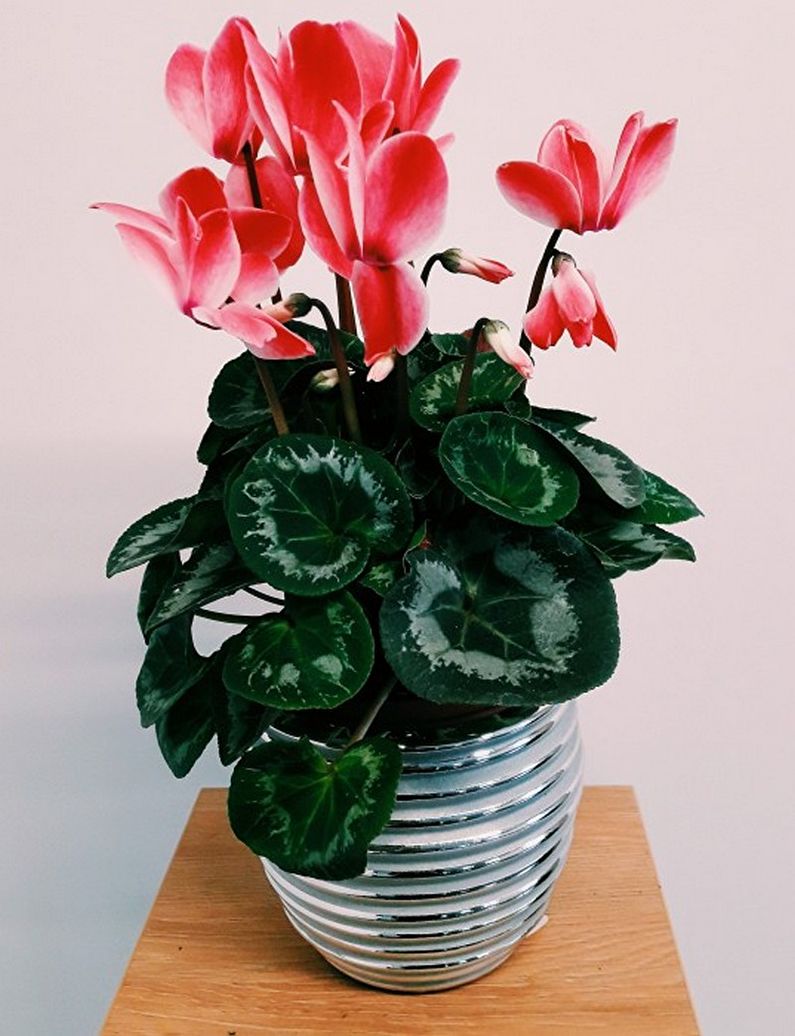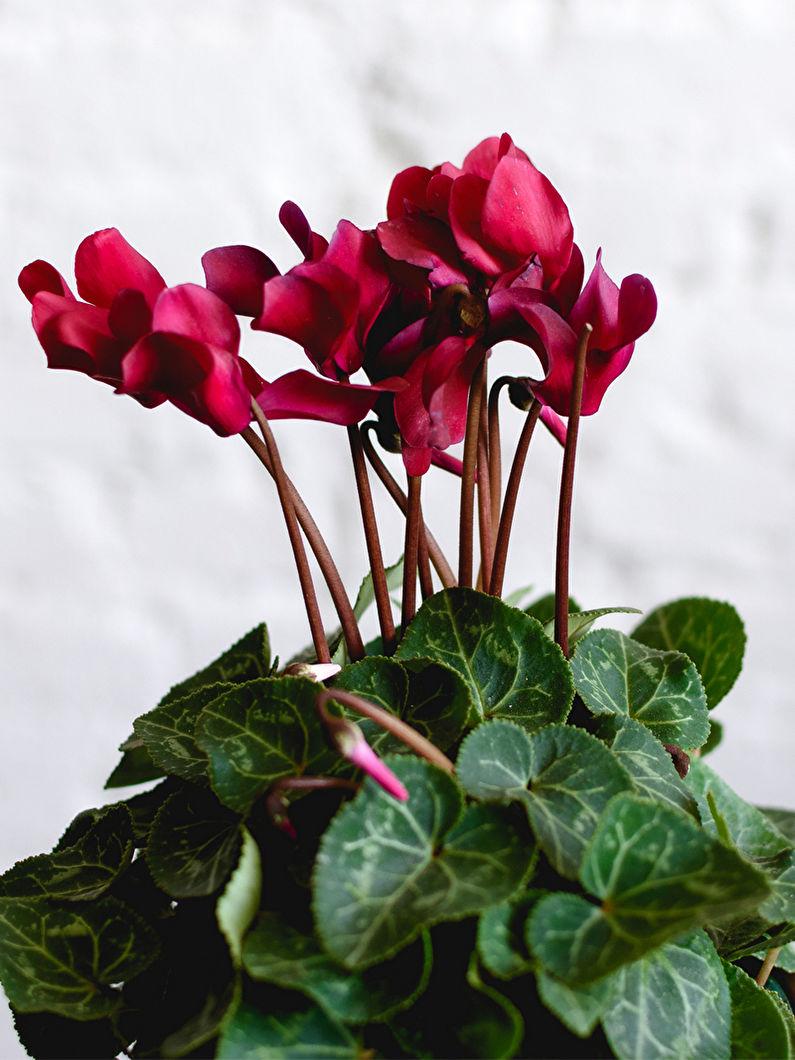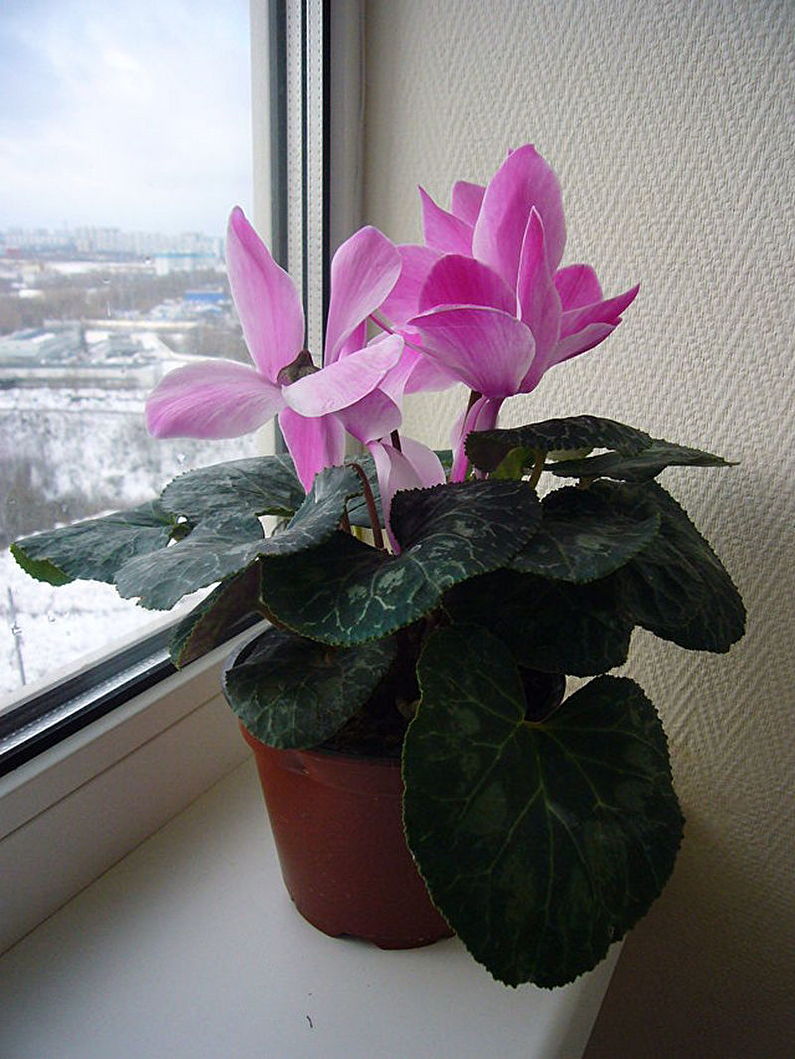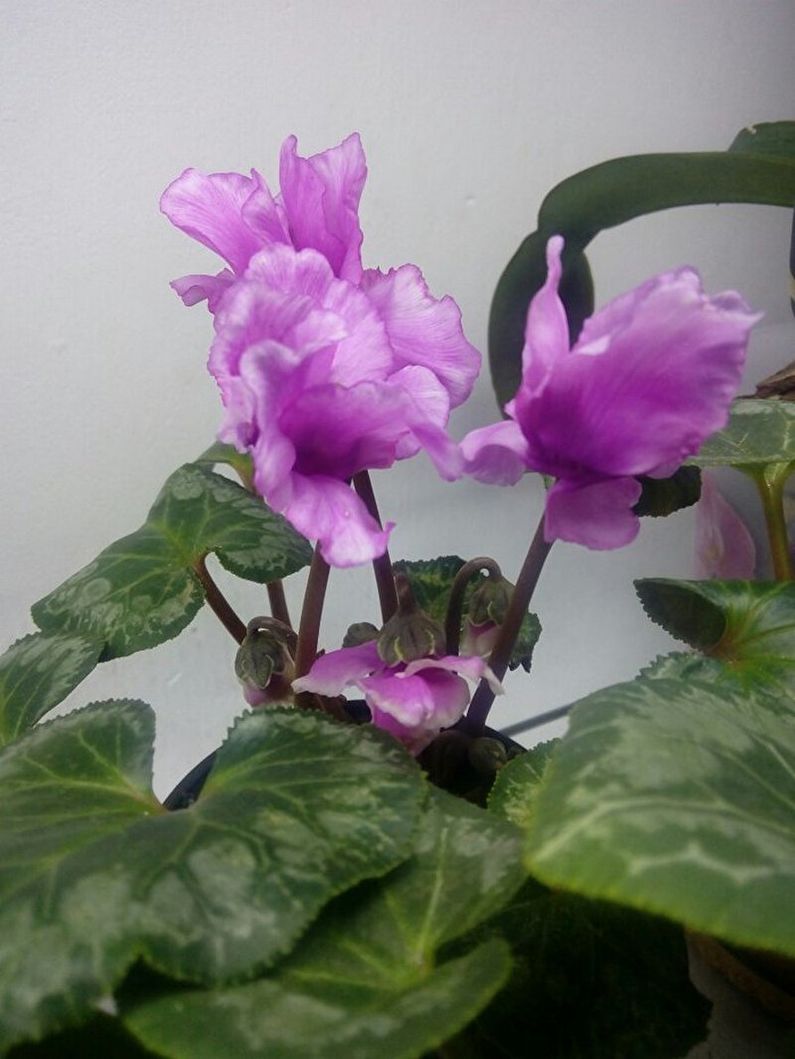
The beautiful homemade cyclamen plant has gained popularity among amateur gardeners with its unmatched beauty of flowering in the winter. This is especially nice, since it is during this period in nature that there are so few bright colors. Many magnificent buds combined with foliage painted with elegant silver-green patterns cannot ignore even the most indifferent to floristry. What are cyclamens, and how to grow such beauty at home? This will be discussed in our article.
The main types
In nature, there are 15 species of cyclamen, common in the Mediterranean, Middle Asia, and the Caucasus. Among indoor crops, two types are most popular - Persian with many excellent varieties and European, which is much less common.
European cyclamen
This species has a flowering period from May to September. Florists do not plant it in flowerpots so often, since it is significantly inferior to Persian varieties in aesthetic indicators. Flowers are much smaller - have a length of about 2 cm, having only a pink palette.
European cyclamen tubers are often irregularly shaped with chaotically extending roots. At the same time, this species is the only non-deciduous among its relatives. When the dormant period begins, it does not grow, but does not shed leaves.
Another advantage is the magnificent aroma, which ranges from a gentle-pleasant to the smell of “expensive perfumes”. Moreover, the intensity of the smell depends on the color of the flower - the brighter it is, the richer the aroma.
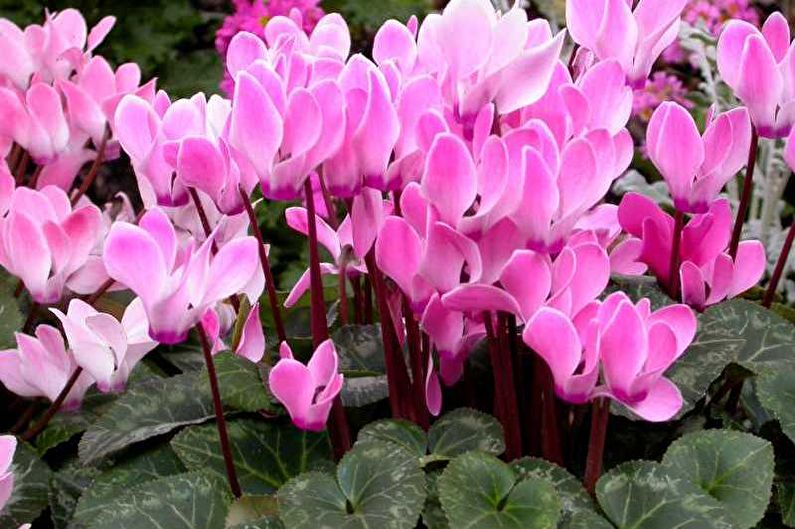
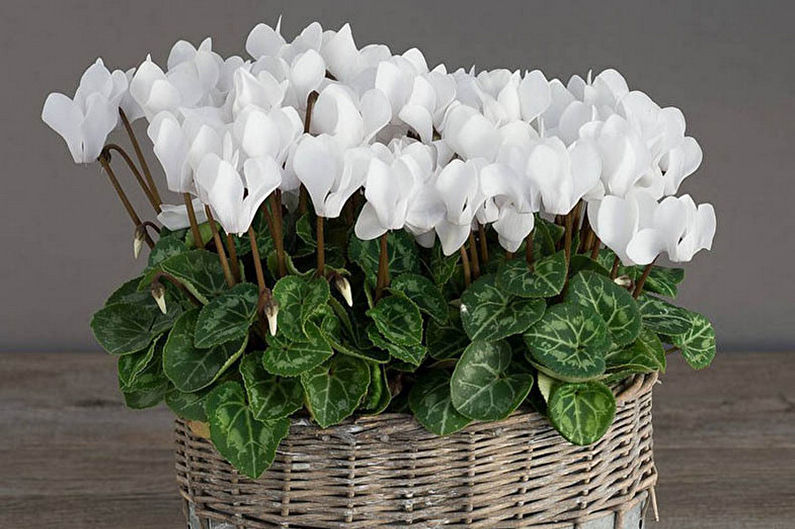
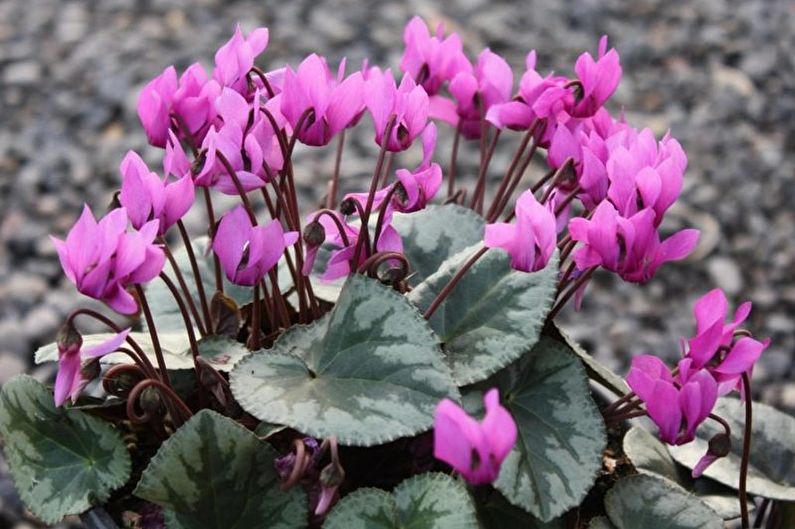
Persian cyclamen
The flowers of the Persian cyclamen are quite large and elegant, somewhat similar to the existing wings of a butterfly. The flowering period is autumn-spring, from October to March. An interesting fact is that one flower lives only 10 days, but for the entire period up to hundreds of buds can bloom on one tuber.
This species has many varieties, which are divided into three groups according to height: low-growing (up to 15 cm), medium-high (up to 25 cm) and standard (up to 30 cm). Among them, one can distinguish such popular varieties as:
- "Scarlet Moth" with bright red flowers of medium size;
- "Charlie" with pure white buds;
- "La Sylphide", having pomegranate flowers with a white border around the edge of the petals;
- "Topaz" with carmine color, etc.
The Roccoco series can be especially distinguished — a Persian species with large double flowers, where the edges of the petals resemble fringe: “Leela”, soft pink “Pink”, “Rose”, “White with an eye”, etc.
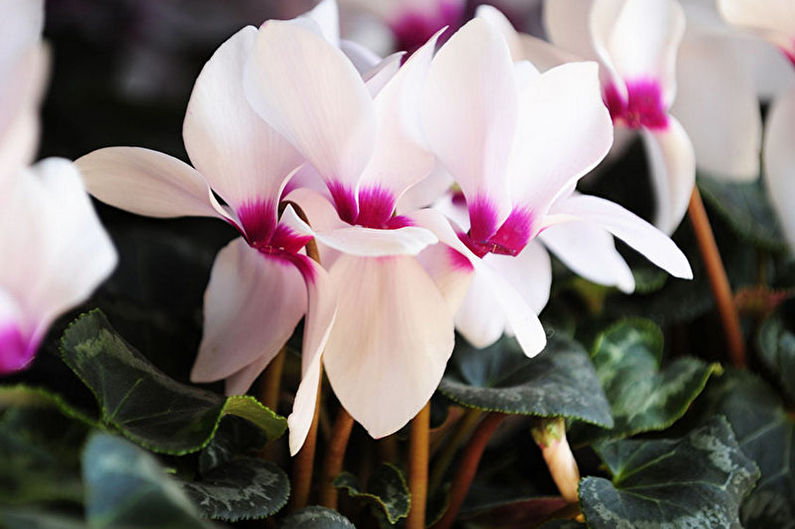
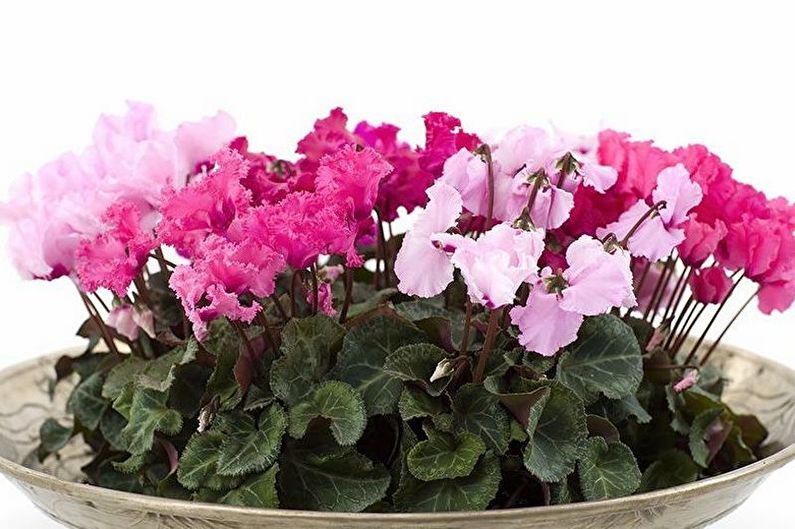
Proper cyclamen care
In order to have a beautiful, healthy, lush plant, it is necessary to provide it with the most favorable climate and care. Often, after the first flowering, cyclamen is simply thrown away, but few people know that in favorable conditions, culture can please its charming beauty of bright red buds for more than one year.
Lighting
Cyclamen is quite photophilous, but direct sunlight is contraindicated for it - it harms buds and leaves. It is better to choose a window or a loggia facing the north side.
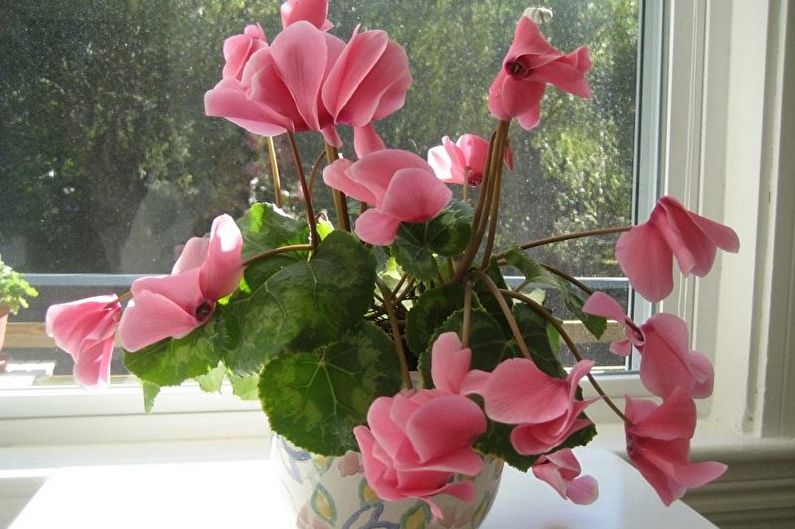
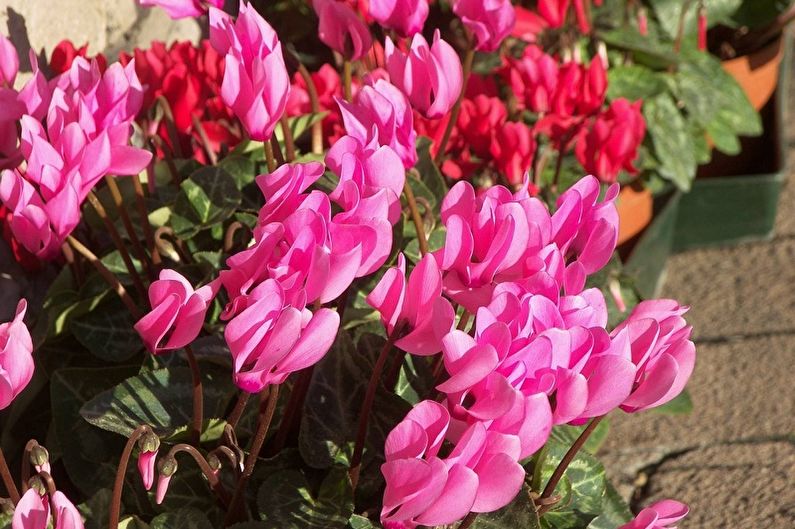
Temperature
Compliance with the temperature regime is one of the main components of competent care for cyclamen. Since the plant prefers cool, the optimum temperature will be + 15 ... + 17C. In the hot season, it is not always possible to maintain a cool microclimate in apartments, but it is advisable to try to keep flowerpots at a temperature not exceeding + 21C. With the beginning of the heating season, it is better to remove the flowers away from heating batteries and other heat emitters in the room.At the same time, the room must be regularly ventilated without creating a draft.
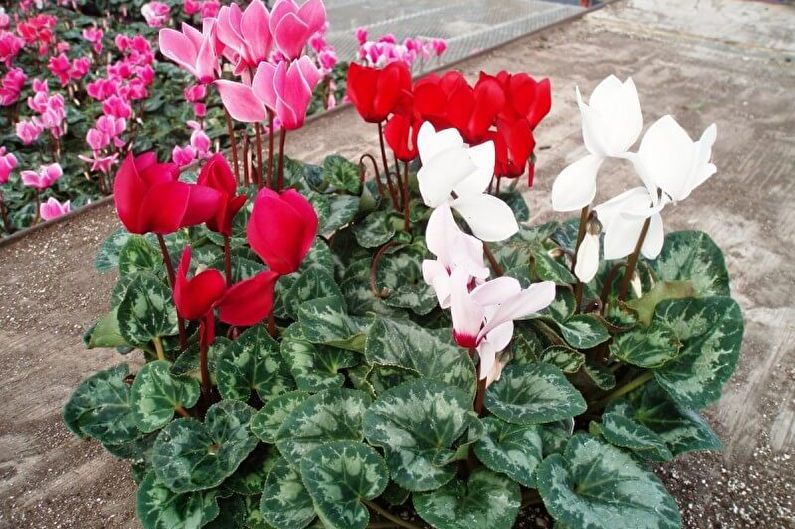
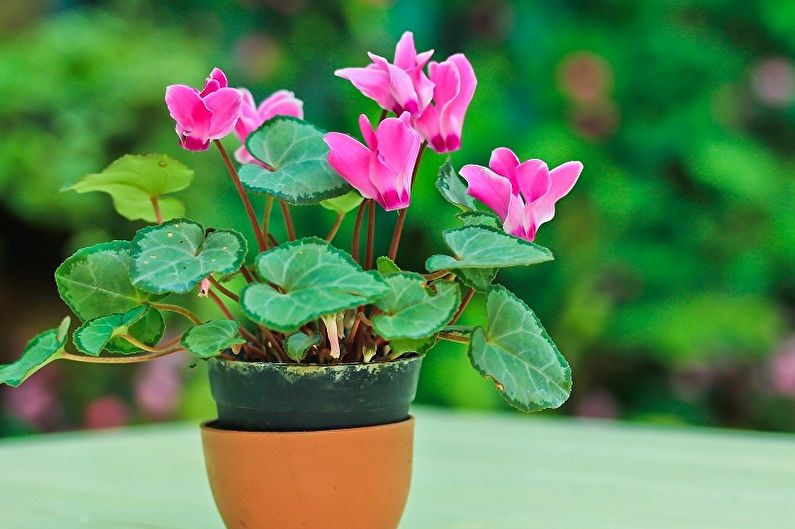
Humidity
In most cases, cyclamen is not required for spraying, with the exception of persistent heat. In this case, you can use the spray gun and moisten the air around the plant. At the same time, you need to carefully monitor that drops of water do not fall on the flowers and shoots - this can lead to a deterioration in its appearance and even death. Pots can be placed on wet expanded clay or pebbles, this is especially true for newly acquired flowerpots. So they better adapt to the dry microclimate of the apartment.
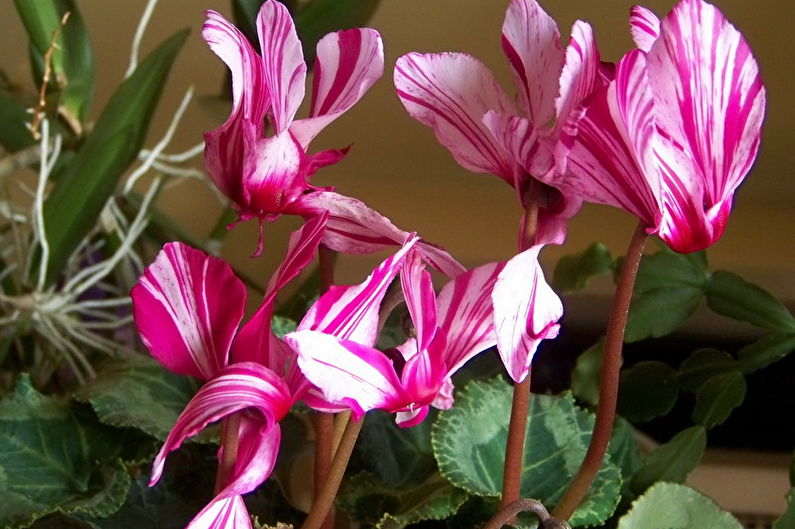
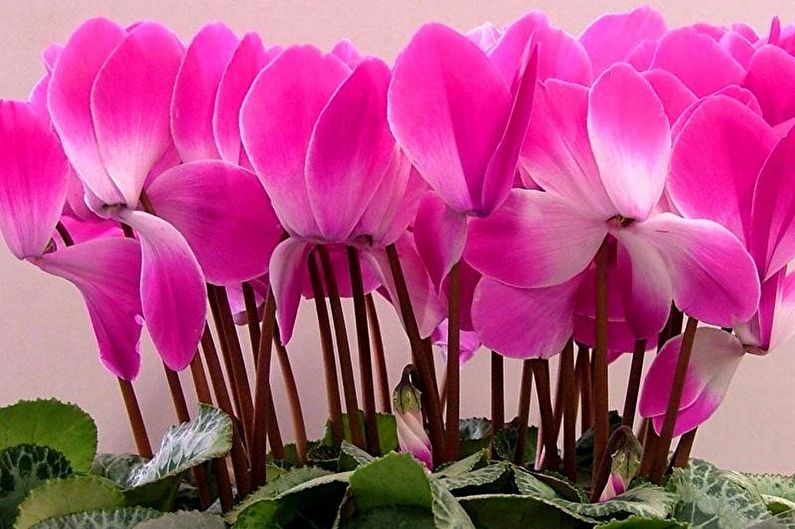
Watering
For proper watering, it is important to know which cyclamen grows in a flowerpot. If this is a variety blooming all year round, it will be the same all year, for the rest, watering should be more intense during the flowering period. Cyclamen loves well-prepared water prepared in advance. Watering is necessary evenly, preventing water from entering the plant so as not to destroy it (you can use a watering can).
Another suitable moisturizing method is immersion. It is necessary to draw water into the container, wait until it settles. The flowerpot should be immersed almost to the level of the sides and kept in this position until a shine of moisture appears on the ground. The pot is taken out of the water, allowed to drain excess water through the holes.
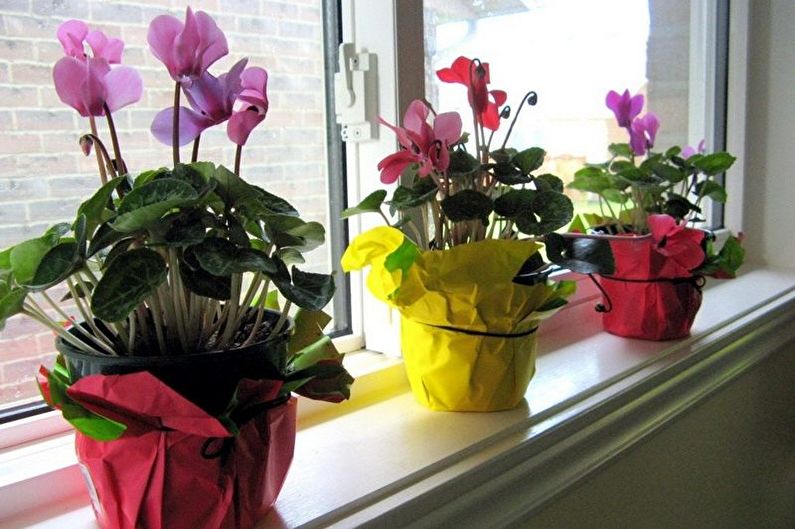
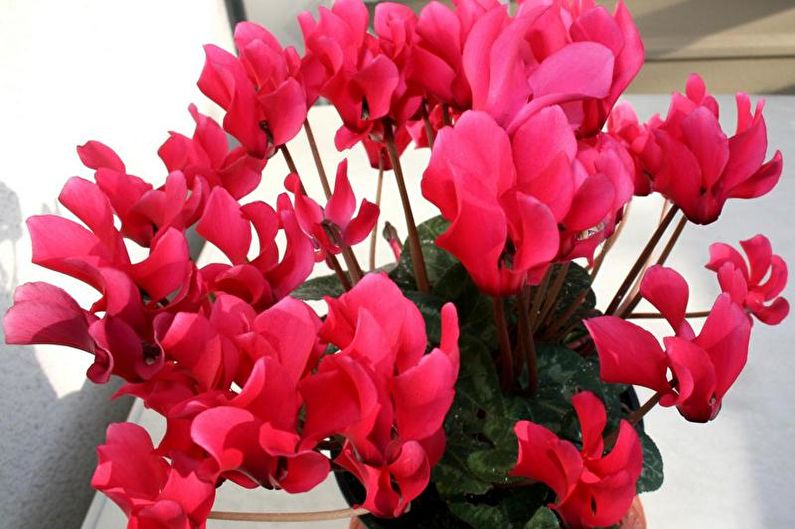
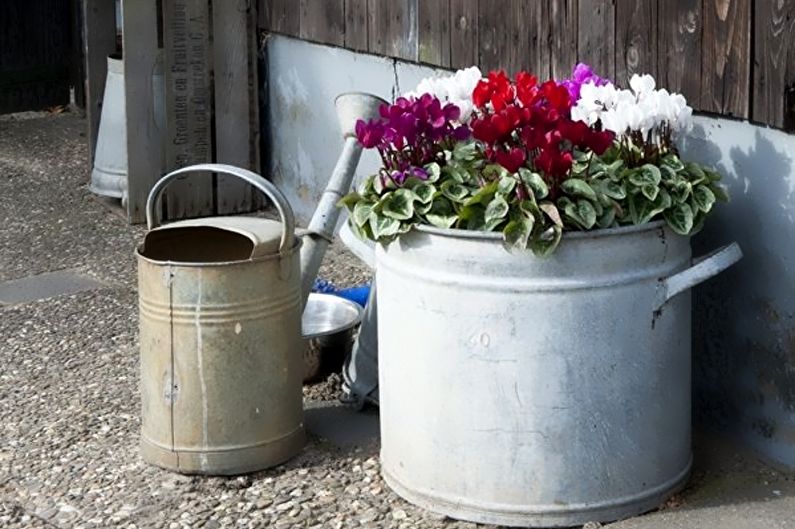
Fertilizers and fertilizing
An important part of cyclamen care is fertilizing the plant with the addition of fertilizers, although some growers refuse chemical fertilizers in favor of proper care. Nevertheless, in order for cyclamen to develop correctly, once a month it can be fed with the “Floretta” liquid preparation, which contains many macro- and microelements that qualitatively saturate the soil. At the same time, it helps to avoid the possibility of the appearance of many diseases that affect flowers. It contains phosphorus, potassium, nitrogen, magnesium and other useful additives.
If the culture has been planted from seeds, with the first appearance of sprouts, it is fed a growth activator. Also, as fertilizer, calcium nitrate is used, which is applied to the soil every ten days while the plant grows.
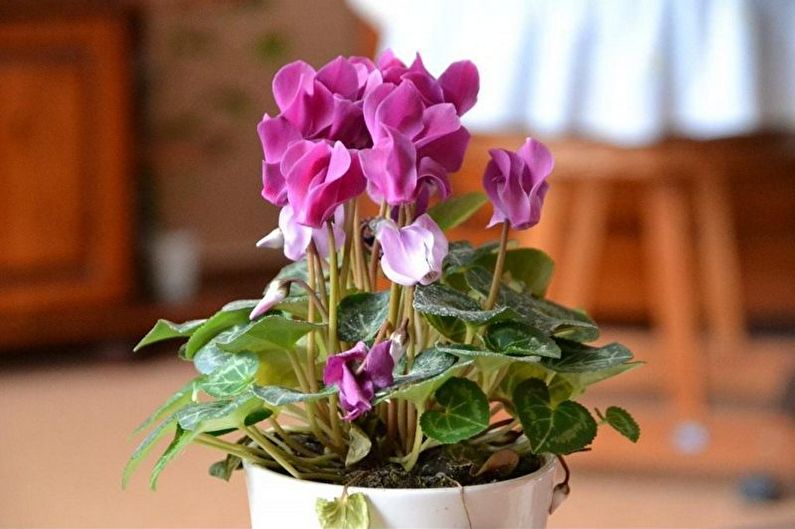
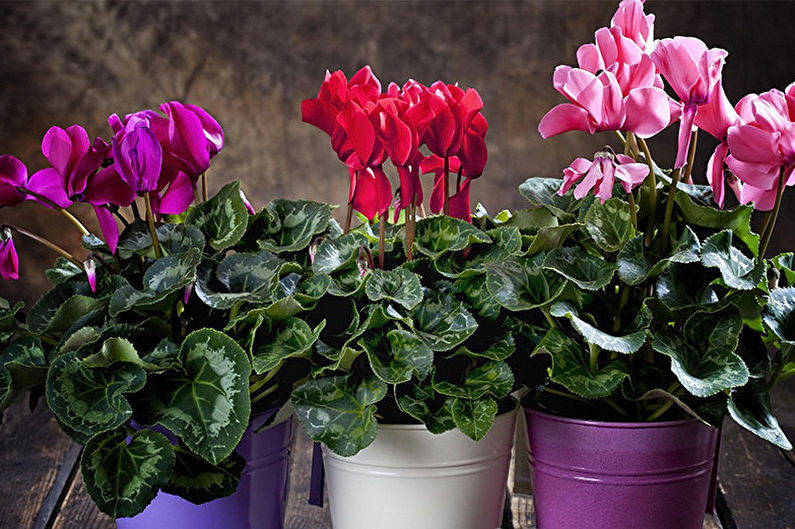
Plant pests and diseases
Cyclamen has a certain predisposition to various kinds of diseases. Improper care can lead to the formation of fungi and rot that can destroy it. The most dangerous are the following factors:
- The appearance of gray rot as a result of fungus. It can be airborne or present in a poor-quality substrate. A sign of damage is a gray coating, turning into brown with softening of tissues. It is better to transplant the plant into new soil and reduce the amount of moisture;
- The defeat of rhizoctonia rot, due to which cyclamen can die very quickly. Depressed spots appear on leaves, tubers, peduncles, on which the fungus propagates. This can happen as a result of improper care - waterlogging, high temperature conditions. It is necessary to immediately stop watering, transplant the plant into a well-ventilated substrate, you can treat it with fungicide, using, for example, "Provicur";
- A tuber disease that is affected by a fungal infection and becomes covered with dead tissue. Gradually, the lower leaves begin to dry out, and then the whole plant dies. The reason is improper care. Cyclamen must be treated with ridomil and create the optimal microclimate.
In addition to diseases, cyclamen may be susceptible to attack by pests. The plant must be carefully inspected if small insects or sticky secrets are found - urgently take action. Pests include a cyclamen tick, scabbard, thrips, etc. The most dangerous is a tick that settles in a colony on the back of the leaves, which over time twist and fold. The plant must be treated with insecticides.
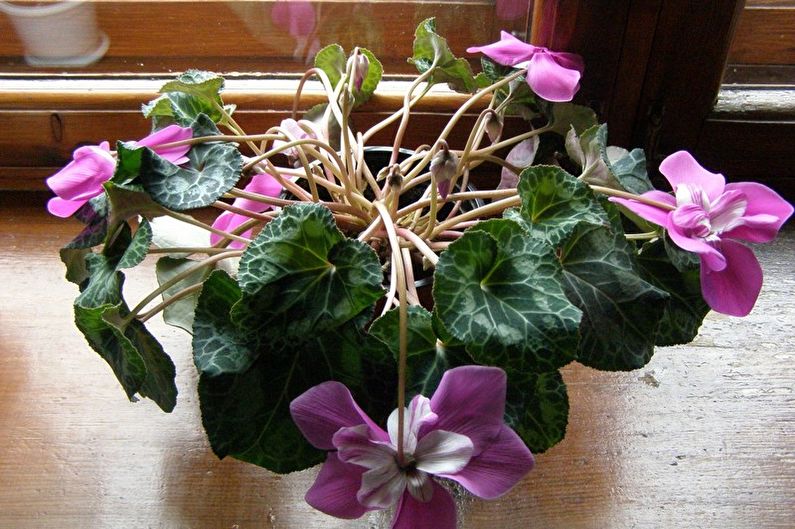
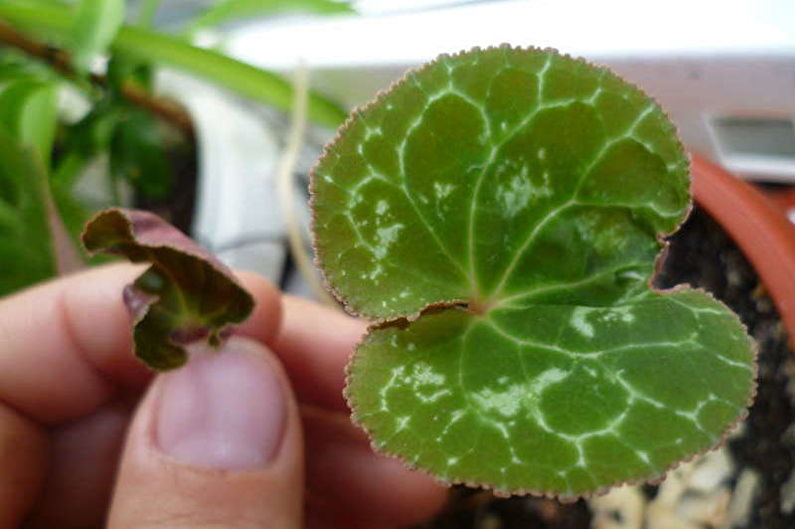
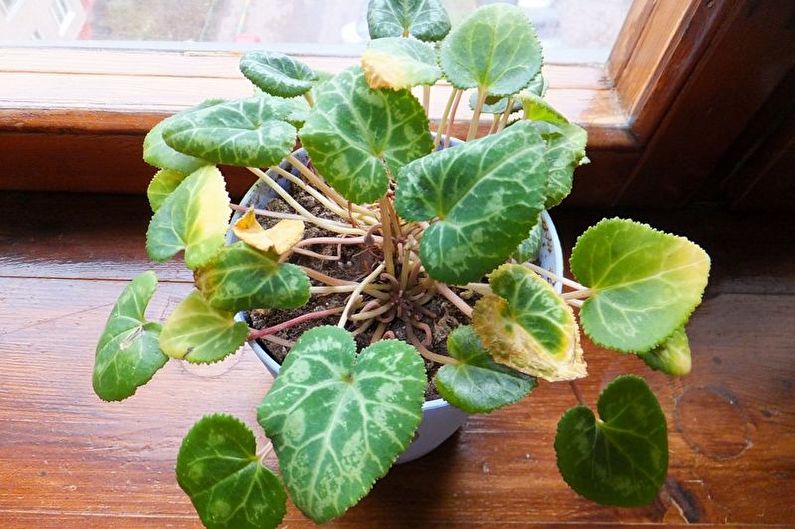
How to transplant cyclamen
In the second half of summer, leaf growth begins.This is the best time for a transplant. The pot should be chosen according to the rule of the golden mean - not too large and not too small, a diameter of 12-14 cm is quite suitable. Since cyclamen is easily affected by pests, before planting, the soil should be steamed well and treated with a light pink solution of potassium permanganate. Also need drainage. The tuber does not completely sink into the ground - about half or 1/3 should remain on the surface. Often a plant is transplanted together with a lump of earth to keep the roots intact.
Transplanted cyclamen requires coolness and light. At first, watering should be moderate, and only when the leaves begin to actively grow, they increase it, add top dressing.
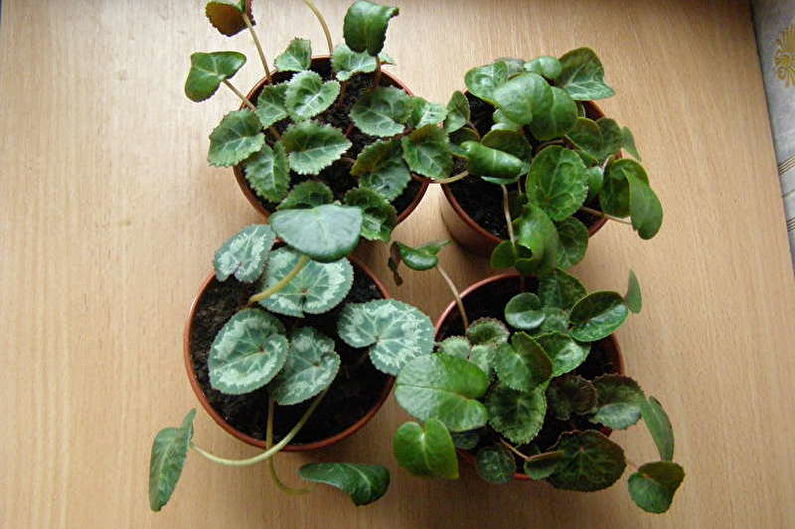

Propagation at home
You can carry out the cyclamen reproduction procedure at home, but, given that the plant is quite whimsical, especially in the early stages of life, you need to correctly approach the preparation of the soil and care. Reproduction is carried out in one of three ways: by seeds, children and dividing the bulbs.
Propagation of cyclamen by seeds
To get new beautiful representatives of this plant, seeds can be purchased or collected. When buying in a store, you should definitely pay attention to the expiration date - usually it is limited to two years. At home, after flowering ends, seed bolls are formed. They will mature for four months, after which it is possible to collect material. The extracted seeds dry well. Landing should begin in early spring. Before this, sand and peat soil should be calcined in the oven, and the seeds should be soaked in a biostimulator, for example, Epin Extra.
They are planted in a low container with moistened holes to a depth of 1 cm and sprinkled with earth. It is better to cover the box with seeds with a black film, since seeds germinate in the dark at a temperature of 18C. When the first shoots appear, cyclamen is transferred to bright light and fertilize. The first flowering is observed after a year or more.
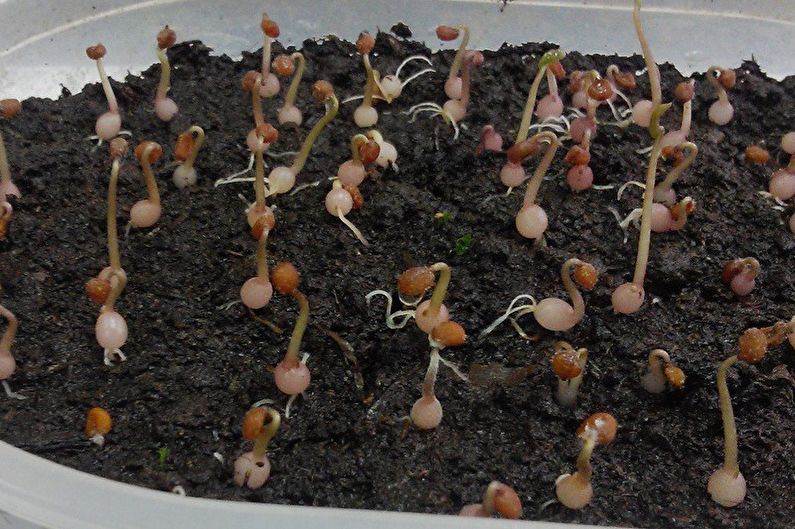

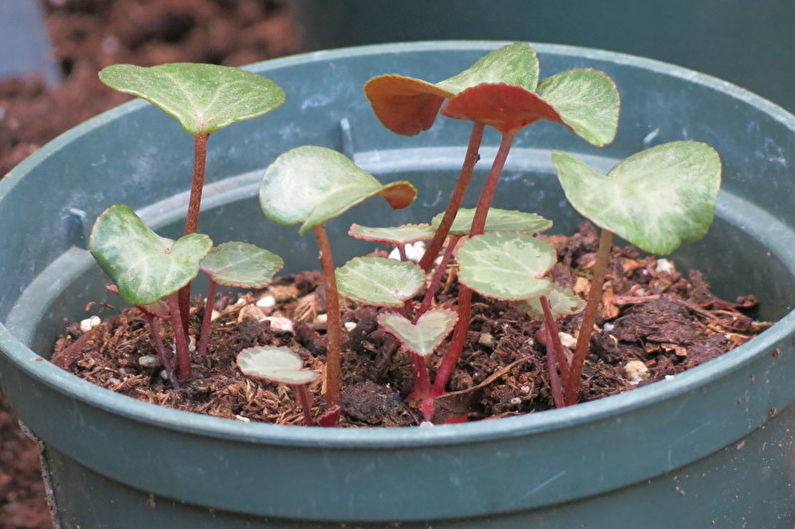
Cyclamen reproduction by children
When replanting a plant after it has flowered, it is necessary to separate the onion bulbs that have appeared in the mother tuber. They are planted in a separate container, steaming before this soil. They are half immersed in the soil and watered. In a week, the first leaves will appear, and the plant will need the first feeding. At the same time, you need to monitor the level of moisture in the soil to avoid waterlogging and the formation of fungus.
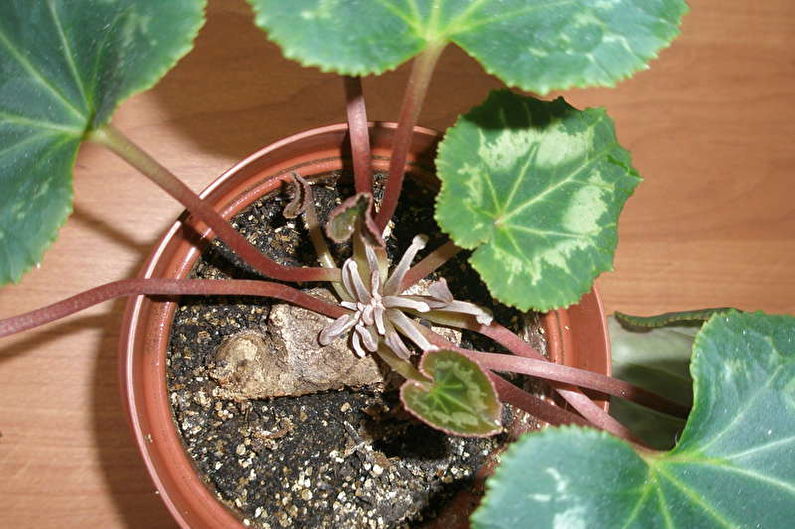
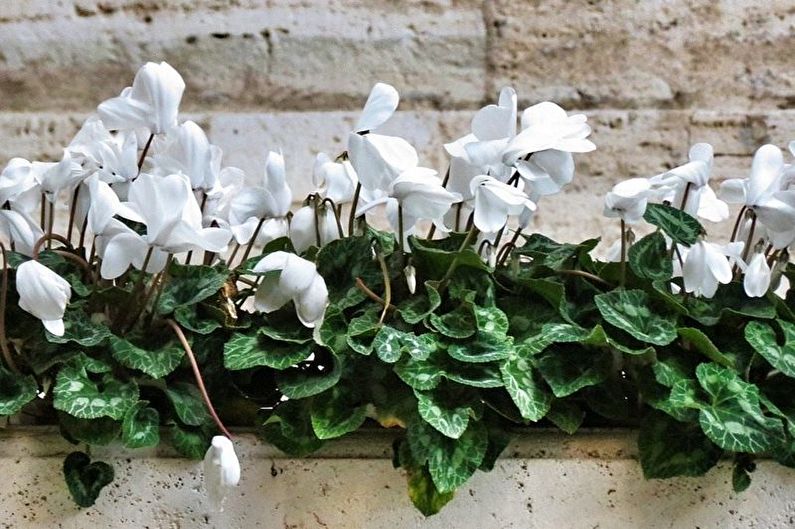
Bulk reproduction of cyclamen
During the dormant period of cyclamen, when it has flowered, the corm should be removed from the ground and dried well. The onion is cut so that each part contains a kidney, and is treated with charcoal. Re-dried material is planted in pots with prepared loose soil, watered and the temperature regime is monitored.

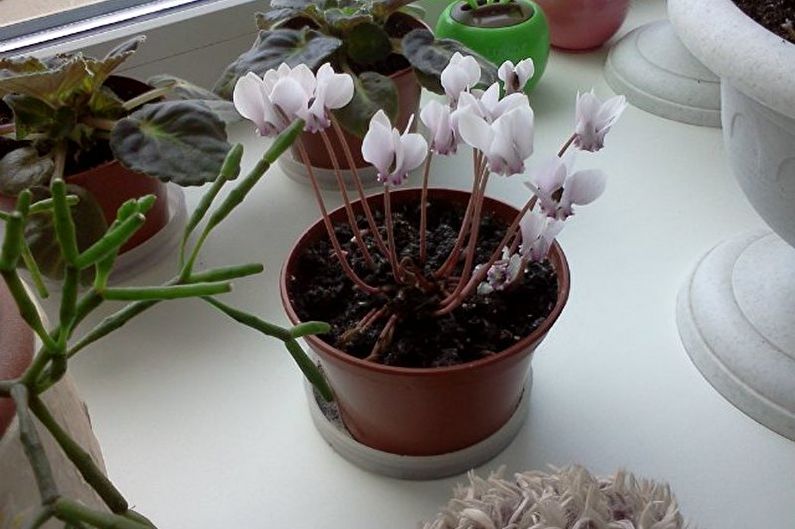
Cyclamen - photo
In order to find out what cyclamen might look like, we suggest you look at our photo selection. Here you will find the best photos with colorful plants, among which you can navigate and pick up cyclamens that you want to see in your home. Enjoy watching!


